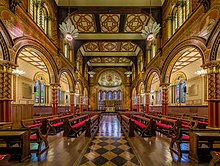King's College London Chapel
| The Chapel of King's College London | |
|---|---|

The Grade I listed college chapel on the Strand Campus seen today was redesigned in 1864 by Sir George Gilbert Scott
|
|
| Basic information | |
| Location | King's College London, Strand, London |
| Geographic coordinates | 51°30′43″N 0°06′54″W / 51.51187°N 0.11506°WCoordinates: 51°30′43″N 0°06′54″W / 51.51187°N 0.11506°W |
| Status | Active |
| Heritage designation | Grade I listed building |
| Architectural description | |
| Architectural type | Chapel |
| Completed |
1831 - Sir Robert Smirke 1864 - Sir George Gilbert Scott |
The Chapel of King's College London is a Grade I listed 19th century chapel located in the Strand Campus of King's College London, London, England. Originally designed by Sir Robert Smirke in 1831, the Renaissance Revival chapel seen today was redesigned by the prominent Victorian Gothic architect Sir George Gilbert Scott in 1864.
The original college chapel was designed by Sir Robert Smirke and was completed in 1831 as part of the College building (later known as the King's building). Given the foundation of the university in the tradition of the Church of England, the chapel was intended to be an integral part of the campus. This is reflected in its central location within the King's Building on the first floor above the Great Hall, accessible via a grand double staircase from the foyer. Although no pictures have survived, the original chapel was described as a low and broad room "fitted to the ecclesiological notions of George IV’s reign." However, by the mid nineteenth century its style had fallen out of fashion and in 1859 a proposal by the college chaplain, the Reverend E. H. Plumptre, that the original chapel should be reconstructed was approved by the college council, who agreed that its "meagreness and poverty" made it unworthy of King's.
The college approached Sir George Gilbert Scott to make proposals. In his proposal of 22 December 1859 he suggested that, "There can be no doubt that, in a classic building, the best mode of giving ecclesiastical character is the adoption of the form and, in some degree, the character of an ancient basilica." His proposals for a chapel modelled on the lines of an classical basilica were accepted and the reconstruction was completed in 1864 at a cost of just over £7,000.
...
Wikipedia
